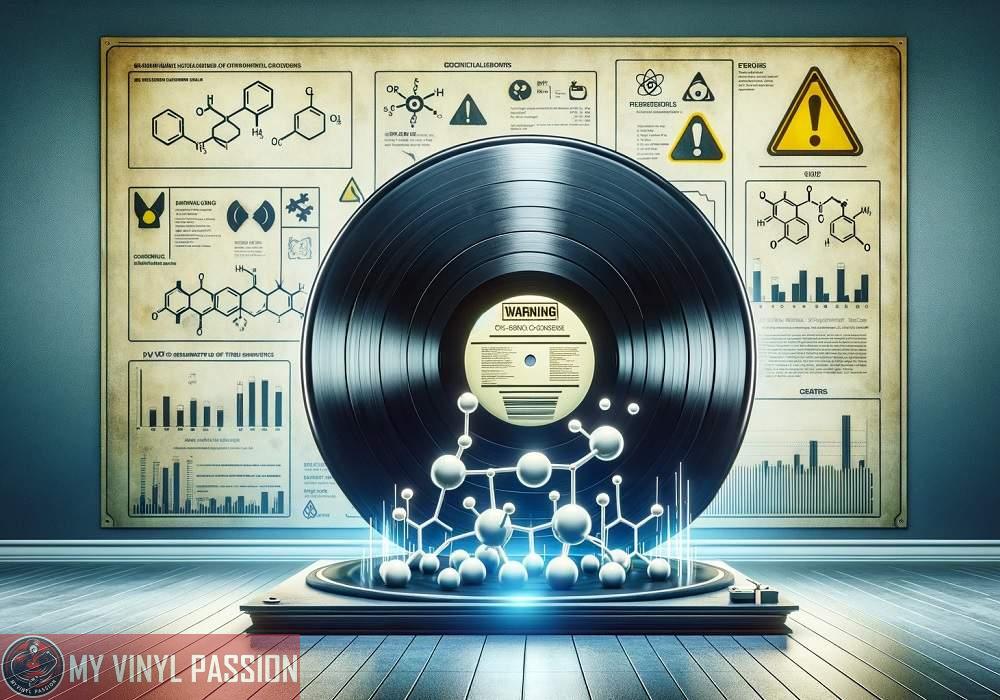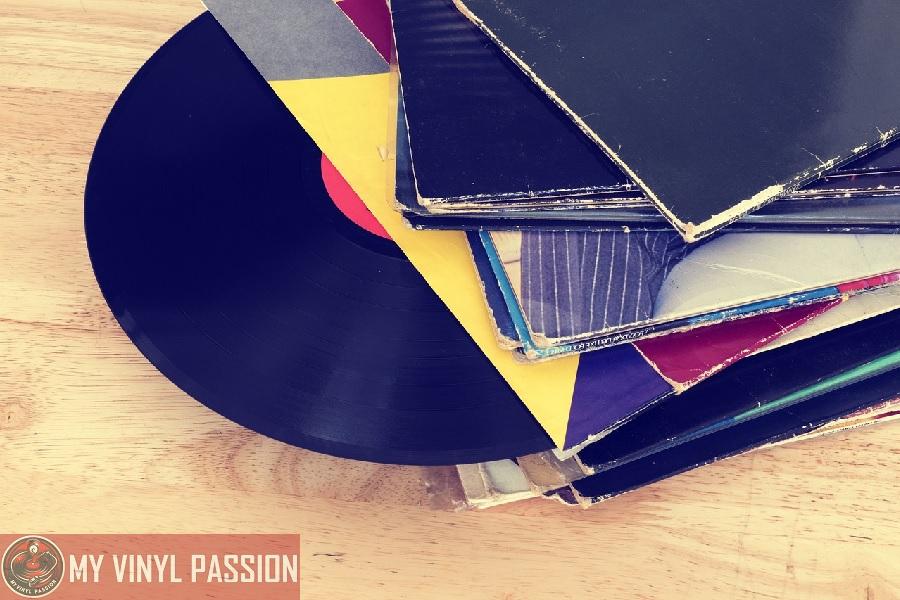Vinyl records have surged in popularity in recent years, bringing into question their environmental impact and potential toxicity.
The primary material in vinyl records is polyvinyl chloride (PVC), which has raised concerns due to its chemical makeup and the effects it can have when manufactured or disposed of improperly.
As we explore the realm of music consumption, the topic of vinyl records’ toxicity is not just a matter of environmental interest but also one of consumer safety.
While vinyl records are not typically harmful to consumers under normal use, their production and disposal raise significant environmental and health concerns due to the toxicity of PVC and the chemicals involved in their manufacture and breakdown.
In Summary
Vinyl records can release toxic substances if they are burned or break down in landfills, raising concerns about their production, disposal, and overall ecological footprint.
Made primarily of PVC, vinyl records also contain additives like stabilizers, plasticizers, and pigments, each playing a role in the record’s durability and sound quality.
The environmental impact of vinyl records is not limited to their material but also includes the industrial processes of their creation and the waste management practices post-consumer use.
In our examination of the materials and lifecycle of vinyl, we uncover that records can indeed release toxic substances if burned or broken down in landfills. The production process of vinyl records involves the use and release of certain chemicals that can be harmful to the environment.
While enjoying the rich sounds of a vinyl record, we must also consider the aftermath of its lifespan and its broader ecological footprint.
To understand the full extent of vinyl toxicity, we assess the studies and discussions surrounding the political ecology of music and its physical manifestations.
We find that it is not just about the potential toxicity of the records themselves but also about the industrial processes that create them and the waste management practices that deal with them post-consumer use.
Our approach is to provide a factual basis for these concerns, anchored in the research that dissects these complex interrelations.
The Composition of Vinyl Records
Vinyl records are primarily made of PVC (polyvinyl chloride), a type of plastic that has been widely used due to its durability and flexibility. PVC begins as a powder and is then transformed through heat and pressure into the smooth discs we know.
In addition to PVC, certain additives are mixed into the compound to achieve desired characteristics:
- Stabilizers: To prevent degradation and discoloration
- Plasticizers: For flexibility and to reduce brittleness
- Pigments: Typically black carbon is used for color consistency
It’s important to understand that each component is meticulously balanced to ensure the record not only holds the intricate grooves but also produces high-fidelity sound when played. Despite the durability of vinyl records, they are susceptible to damage if not handled and stored properly.
Records are constructed in several layers:
- Label: The center sticker with artist and track information
- Grooves: Spiral etchings that encode the sound
- Substrate: The main body of the disc
During production, the vinyl compound is pressed between two metal plates – known as stampers – which imprint the grooves onto the heated material.
Concerns about the potential toxicity of vinyl records arise when considering the lifecycle of PVC. When improperly disposed of, this material can release harmful chemicals if incinerated or left to decompose in less controlled environments. Our interest in the longevity of records must be balanced with an understanding of environmental responsibilities.
Chemical Characteristics of Vinyl
In this section, we explore the fundamental chemical makeup of vinyl, focusing on the primary material used in its production and the various additives that enhance its properties.
PVC and Its Constituents
Polyvinyl chloride, or PVC, is the main component of vinyl records. It is a synthetic plastic polymer that is rendered pliable and moldable through the use of certain chemical additives.
The base structure of PVC consists of a carbon backbone with alternating chlorine atoms. Its chemical formula is typically written as -(CH2-CHCl)n-, where the “n” denotes the repeat unit of the polymer chain. PVC is a versatile material due to its resistance to environmental degradation and its structural stability.
Additives in Vinyl Production
During the production of vinyl records, various additives are incorporated into the PVC to achieve desired characteristics. These additives can influence the flexibility, color, and overall durability of the final product. Some common additives include:
- Plasticizers: These are added to increase the flexibility of the vinyl, with phthalates being the most common type.
- Heat stabilizers: These prevent thermal degradation during the manufacturing process and extend the lifespan of the vinyl record.
- Fillers: Materials such as calcium carbonate can be added to enhance the vinyl’s mechanical properties.
Each of these additives is carefully selected to ensure the proper function and longevity of vinyl records while adhering to safety and environmental regulations.
Manufacturing Process and Toxicity
Vinyl records are crafted through a detailed process involving various chemicals, and our aim is to unpack the potential for toxicity at different stages.
Production Stage Hazards
In the production of vinyl records, we encounter various compounds, some of which may present hazards. The main material, polyvinyl chloride (PVC), releases toxic fumes when heated to the necessary temperatures for molding records.
The hazards aren’t just confined to the material itself; the stabilizers and plasticizers added for flexibility and durability can also contain harmful substances.
Waste Disposal and Environmental Impact
Our focus extends to the end of a vinyl record’s life cycle as well. Improper disposal can lead to these materials releasing harmful chemicals into the environment.
Especially concerning are the gallons of poisonous volatile organic compounds noted in the waste from electronic and tech manufacturing, which includes the production of items such as vinyl records.
These substances can contaminate our natural resources and are a poignant reminder there is no such thing as completely ‘green’ physical media.
Health Impacts of Vinyl Exposure
In considering the health impacts of vinyl, we turn our attention to both the immediate potential risks from direct contact and the long-term effects that may arise from chronic exposure.
Direct Contact Risks
When handling vinyl records, the risk of toxicity through direct contact is generally low. But, the manufacturing process of vinyl involves chemicals like vinyl chloride, which is a carcinogen when inhaled or absorbed through the skin in significant amounts.
Long-Term Exposure Effects
Long-term exposure to vinyl chloride from various industrial processes can have serious health implications.
Workers in environments where vinyl chloride is present at high levels over extended periods may experience an increased risk of rare forms of liver cancer, as well as damage to the liver, lungs, and central nervous system.
Safety Standards and Regulations
In approaching the topic of vinyl record toxicity, it is pivotal to understand the established safety protocols within the industry as well as the health regulations set forth by governments.
Industry Safety Protocols
Our industry adheres to rigorous safety protocols to mitigate the potential for toxic exposure.
This includes standard practices such as the use of protective equipment and regular monitoring of air quality in production facilities.
For instance, during the manufacturing process of vinyl records, we ensure that the levels of any potentially toxic substances, like vinyl chloride, remain well below the occupational exposure limits as recommended by agencies such as the Occupational Safety and Health Administration (OSHA).
Detailed information about workplace exposure to vinyl chloride is essential for understanding how these safety standards are practically applied.
Governmental Health Regulations
Regulations play a crucial role in ensuring public safety, and our adherence to them is non-negotiable.
Regulations concerning the production and disposal of vinyl records are informed by substantial research on the effects of chemicals used in their production. Our compliance involves regular assessments to adhere to the guidelines set by entities such as the Environmental Protection Agency (EPA) and other international standards.
These assessments are crucial to certify that harmful agents in our production process are kept to a minimum relative to the costs and benefits of the regulations. We stay updated on the implementation of uniform standards and any necessary regulatory reforms that impact our industry practices.
Recycling and Disposal of Vinyl Records
Vinyl records hold significant cultural value but also present environmental challenges. We must consider both recycling and safe disposal to address these challenges effectively.
Recycling Processes
Our approach to recycling vinyl records involves breaking down the material into small granules. These granules can then be repurposed to manufacture new vinyl products. However, the recycling of vinyl records is not always straightforward due to the complexity of the materials. Vinyl, specifically PVC (polyvinyl chloride), is a type of plastic that requires specialized processes.
- Mechanical Recycling: The records are physically ground into smaller pieces which are then melted and remolded.
- Chemical Recycling: This process breaks down the chemical structure of PVC and reforms it into new material.
Safe Disposal Methods
When recycling isn’t an option, safe disposal is imperative to prevent environmental harm.
The key is ensuring that records are disposed of in a way that they don’t contribute to pollution. Specialized waste management facilities can handle vinyl records and other PVC products by incineration, following stringent environmental guidelines to reduce the release of toxins.
We advise:
- Checking with local recycling facilities: Some may accept vinyl records or can direct you to a facility that does.
- Avoiding landfill disposal: We prevent potential leaching of chemicals into the environment.
- Utilizing specialized services: Organizations exist that specifically collect vinyl for recycling or safe disposal.
Alternatives to Vinyl Records
As we explore more sustainable and modern ways to enjoy music, we consider alternatives to traditional vinyl records.
These alternatives include digital formats and eco-friendly physical media, each offering unique advantages.
Digital Formats
We are in an era where digital music formats have become prevalent. The shift to digital encompasses downloadable files like MP3s and high-resolution audio formats such as FLAC and ALAC.
Streaming services have also revolutionized the way we access music, offering vast libraries at our fingertips. Digital music provides convenience and portability, removing the need for physical storage. Moreover, digital formats lack the potential toxicity associated with the materials used in vinyl production.
- Advantages of Digital Formats:
- Portability and accessibility
- No physical material production required
- Offers the potential for high-quality audio without the degradation over time
Eco-Friendly Physical Media
For those of us who prefer a tangible music collection, there are eco-friendly alternatives to vinyl.
Innovations in this realm include records made from biodegradable materials or recycled goods. Some companies are now producing records using a variety of non-toxic, sustainable compounds that mimic the grooves and sound quality of traditional vinyl without the environmental drawbacks.
- Advantages of Eco-Friendly Physical Media:
- Reduced environmental impact
- Retains the tangible experience of music collection
- Sustainable and potentially less toxic than traditional vinyl materials
By considering these alternatives, we enjoy our favorite tunes while minimizing our ecological footprint and potentially reducing our exposure to the materials that raise concerns in vinyl records.
Public Perception and Consumer Responsibility
In exploring the question of whether vinyl records are toxic, it’s critical to address both public perception and consumer responsibility.
This scrutiny comes in light of concerns about the environmental and health impacts of vinyl production and disposal.
We can begin by noting that the public consciousness around vinyl records typically associates them with nostalgia and audio fidelity rather than toxicity.
Nevertheless, as informed consumers, we must acknowledge that the PVC (polyvinyl chloride) used in vinyl record production has raised environmental and health concerns due to the release of harmful chemicals during manufacturing and disposal.
Here are some key points that reflect our duties as consumers:
- Educate Ourselves: Learning about the components and life-cycle of vinyl records helps us make informed decisions.
- Assess Impact: Understanding the potential health and environmental risks associated with vinyl records prompts us to consider alternatives.
- Support Responsible Practices: Seeking out and supporting manufacturers who adopt less harmful production methods is a positive step.
In response to these concerns, some consumers have made efforts to minimize their impact, such as opting for digital formats or purchasing used records to extend the life of existing vinyl.
Ultimately, we share a collective responsibility to make choices that reflect both our love for music and our commitment to environmental sustainability.
FAQs
What material are vinyl records made of, and is it toxic?
Vinyl records are primarily made of polyvinyl chloride (PVC), a type of plastic. PVC itself is not toxic to handle, but it can release harmful chemicals during production or if incinerated.
Is it safe to handle vinyl records regularly?
Yes, it is generally safe for consumers to handle vinyl records. The risk of toxicity from direct contact is low, as harmful chemicals are typically released during manufacturing or improper disposal, not during regular handling.
Can the production of vinyl records be harmful to the environment?
The production of vinyl records involves chemicals that can be harmful to the environment. PVC manufacturing can release toxic substances, and improper disposal of vinyl can lead to environmental pollution.
Are there toxic substances released when vinyl records are disposed of?
If vinyl records are incinerated or break down in landfills, they can release harmful chemicals like dioxins and hydrochloric acid, contributing to air, water, and soil pollution.
Can vinyl records be recycled to prevent toxicity?
Recycling vinyl records is challenging due to the complex nature of PVC and the additives used. Some specialized facilities can recycle PVC, and there are creative ways to repurpose vinyl records to prevent them from ending up in landfills.





